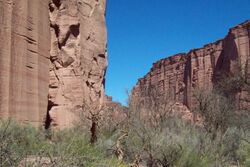Earth:Talampaya Formation
| Talampaya Formation Stratigraphic range: Olenekian ~251.3–247.2 Ma | |
|---|---|
 Sandstones in Talampaya National Park | |
| Type | Geological formation |
| Unit of | Paganzo Group |
| Underlies | Tarjados Formation |
| Overlies | Basement |
| Thickness | Up to 400 m (1,300 ft) |
| Lithology | |
| Primary | Sandstone |
| Other | Conglomerate, tuff |
| Location | |
| Coordinates | [ ⚑ ] : 29°36′S 68°06′W / 29.6°S 68.1°W |
| Paleocoordinates | [ ⚑ ] 46°00′S 40°12′W / 46.0°S 40.2°W |
| Region | La Rioja Province |
| Country | |
| Extent | Ischigualasto-Villa Unión Basin |
| Type section | |
| Named for | Talampaya River |
| Named by | Romer & Jensen |
| Year defined | 1966 |
The Talampaya Formation is an Early Triassic (Olenekian) geologic formation in the Ischigualasto-Villa Unión Basin of La Rioja Province in northwestern Argentina . The pink to red sandstones of the formation represent the oldest sedimentary unit in the basin, overlying basement rock and were deposited in a high-energy braided river environment. Ichnofossils, probably left by an archosaur chirotherian, were found in the formation. The formation crops out in the Talampaya National Park, which was designated a UNESCO World Heritage Site in 2000.
Description
The formation was first defined by Romer and Jensen in 1966,[1] based on a type section exposed in the Talampaya River canyon.[2] The Talampaya Formation belongs to the Paganzo Group.[3]
The formation represents the oldest sedimentary unit in the Ischigualasto-Villa Unión Basin in the Talampaya National Park of La Rioja Province, overlying Paleozoic basement, formed by the Tuminico Formation.[4] The Talampaya Formation is overlain by the arid fluvial sandstones and conglomerates of the Tarjados Formation, eroding the Talampaya Formation.[5]
The formation, reaching a maximum thickness of 400 metres (1,300 ft) with a general thickness of approximately 260 metres (850 ft),[6][7] comprises pink to reddish sandstones,[8] deposited in a fluvial environment, dominated by high-energy braided rivers producing sheet floods.[9][10] The sediments were deposited under uniform climatic conditions with temperate to warm temperatures and high humidity.[11] Other facies recognized in the formation are alluvial fan deposits with thin tuffaceous beds and conglomerates, covered by a section of basaltis and other volcanic agglomerates and eolian sandstones.[12]
Tetrapod ichnofossils, probably belonging to a chirotherian (and possibly an archosaur),[11] were discovered in the formation southeast of Pagancillo by Argentina paleontologist José Bonaparte in 1964.[3]
See also
- Sanga do Cabral Formation, contemporaneous fossiliferous formation of the Paraná Basin in southeastern Brazil
- Katberg Formation, contemporaneous fossiliferous formation of the Karoo Basin in South Africa
- Fremouw Formation, contemporaneous fossiliferous formation of Antarctica
References
- ↑ Caselli, 1998, p.22
- ↑ Caselli, 1998, p.23
- ↑ 3.0 3.1 Leonardi, 1994, p.19
- ↑ Aceituno Cieri et al., 2015, p.59
- ↑ Balabusic et al., 2001, p.26
- ↑ Aceituno Cieri et al., 2015, p.60
- ↑ Monetta et al., 2000, p.648
- ↑ Talampaya Formation
- ↑ Caselli, 1998, p.147
- ↑ Balabusic et al., 2001, p.25
- ↑ 11.0 11.1 Balabusic et al., 2001, p.28
- ↑ Caselli, 1998, p.24
Bibliography
- Aceituno Cieri, P.; M.E. Zeballos; R.J. Rocca; R.D. Martino, and C. Carignano. 2015. Condicionantes geológicos en el cruce de la sierra de Valle Fértil. San Juan - Geological constraints at the crossing of sierra Valle Fertil. San Juan. Revista de Geología Aplicada a la Ingeniería y al Ambiente 35. 57–69.
- Balabusic, Ana M., et al. 2001. Plan de Manejo del Parque Nacional Talampaya, 1–68. Administración de Parques Nacionales. Accessed 2019-03-28.
- Caselli, Alberto Tomás. 1998. Estratigrafía y sedimentología de las formaciones Patquía (Pérmico) y Talampaya (Triásico Inferior), en las Sierras Pampeanas Noroccidentales y Precordillera Central (Provincias de La Rioja y San Juan) (PhD thesis), 1–437. Universidad de Buenos Aires. Accessed 2019-03-28.
- Leonardi, Giuseppe. 1994. Annotated Atlas of South America Tetrapod Footprints (Devonian to Holocene) with an appendix on Mexico and Central America, 1–248. Ministerio de Minas e Energia - Companhia de Pesquisa de Recursos Minerais, Geological Service of Brazil. Accessed 2019-03-28.
- Monetta, A.; J. Baraldo; A. Cardinali; R. Weidmann, and M. Lanzilotti. 2000. [[1] Distribución y características del magmatismo intratriasico de Ischigualasto, San Juan, Argentina], 644–648. IX Congreso Geológico Chileno. Accessed 2019-03-28.
Further reading
- Bonaparte, J.F. 1978. El Mesozóico de América de Sur y sus Tetrapodos - The Mesozoic of South America and its tetrapods. Opera Lilloana 26. 1–596.
 |


